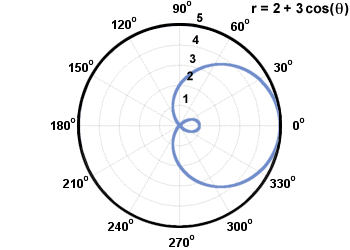Polar Equations:
in the cartesian plane, points are at (x,y) with x being horizontal displacement from the origin and y being the vertical displacement. with polar equations, we use the coordinates (r,Θ) with r being the distance between the point and the pole and Θ being the angle betweent the polar axis and the ray containing the point whose endpoint is also the pole (see figure).

to convert a regular equation to a polar equation, we use:
we also know that a circle centered at the origin has the equation R2 = x2 + y2 but in polar form we have r = R; so for example, a circle with radius 5 has the polar equation r = 5
For circles;
the common circle, r=c where c is a constant. for a circle that intersects the pole once has the equation r=acosΘ or r=asinΘ where a is the diameter of the circle
For limacons;
r=a+bcosΘ or r=a+bsinΘ where a,b≠0
For petal curves;
r=a cos nΘ or r=a sin nΘ. If n is a positive even integer, then the curve has 2n petals. If n is a positive odd integer, the curve has n petals. If n is not and integer, then the petals overlap. The length of the petals is a.
For spirals;
there are two common kinds of spirals;
Archimides spiral which has the equation r=aΘ+b and
logistic spiral which has the equation r=abΘ







Polar Rose Circle Limacon


Archimedes Spiral Logistic Spiral
Problems:
1) Given a point in rectangular coordinates (x, y), express it in polar coordinates (r, θ) two different ways such that 0≤θ < 2π: (x, y) = (- 4, 0)
a) (-4,π), (4,0)
b) (4,-π), (-4,0)
c) (4,π), (-4,0)
d) (-4,-π), (4,0)
2) Decide whether each of the following polar graphs is a limacon, a rose curve, a spiral, a circle, or none of these:
a) r = 2 + cos(θ)
b) r = 2
c) r = sin(3θ)
d) r = 1 - cos(θ)
e) r = 2θ
3) Convert to rectangular form the circle, with the polar equation, R = 4sint
a) x 2 + y 2 + 4 y = 0
b) x 2 + y 2 - 4 y = 0
c) x 2 - y 2 - 4 y = 0
d) x 2 - y 2 + 4 y = 0
4) The area of the closed region bounded by the polar graph of r = 2 + 2cosθ is
a) 4.712
b) 9.424
c) 18.849
d) 37.699
e) 75.398
5) Find the intercepts and zeros of the following polar equations:
a) r = cos(θ) + 1
b) r = 4 sin(θ)
6) Consider the polar curve r = 2 sin(3θ) for 0≤θ≤π
(a) In the xy-plane provided below, sketch the curve.
(b) Find the area of the region inside the curve.
(c) Find the slope of the curve at the point where θ = π/4
Visual Aid:
http://www.analyzemath.com/polarcoordinates/polarcoordinates.html
http://www.ies.co.jp/math/java/calc/sg_kyok/sg_kyok.html
Sources:
http://ltcconline.net/greenl/courses/107/PolarParam/POLAR.HTM
http://www.sparknotes.com/math/precalc/parametricequationsandpolarcoordinates/section2.rhtml
http://www.sparknotes.com/math/precalc/parametricequationsandpolarcoordinates/section3.rhtml
http://en.wikipedia.org/wiki/Polar_coordinates
http://jwilson.coe.uga.edu/EMT668/EMAT6680.2003.fall/Ramachandran/Assignments/Asmt11/assingment_11/assignment_11.htm
Solutions:
1) C
2) limacon; circle; rose curve; limacon; spiral
3) B
4) C
5) (2, 2nπ), (0,(2n + 1)π), where n is an integer; (0, nπ) where n is an integer
6)
 ; A=π; dy/dx = 1/2
; A=π; dy/dx = 1/2


For additional problems, go to:
http://education.yahoo.com/homework_help/math_help/problem_list?id=miniprecalcgt_7_1
Comments (4)
Anonymous said
at 9:19 am on Feb 8, 2008
I liked this page. I had forgotten what and how Polar equation/cooardinates worked and I thought the explanation at the top is eloquent in its brevity. The visuals were definitly well used.
Anonymous said
at 9:41 am on Feb 8, 2008
Like Ben said, I really liked the clarity of the explanation. The combination of the equations and graphs really helped to solidify an idea of the concept in my mind. -Rachel
Anonymous said
at 10:10 am on Feb 8, 2008
I find polar equations the most difficult to understand/remember and your concise presentation of formulas and diagrams were helpful in reminding me that polar equations still exist and how to understand/solve them.
~Marissa
Anonymous said
at 8:07 am on Feb 21, 2008
Very nice drawings. One problem discusses material (how to find the area enclosed by a polar curve) that we haven't covered yet. Also, be sure to check for typos (like in the very first sentence).
You don't have permission to comment on this page.